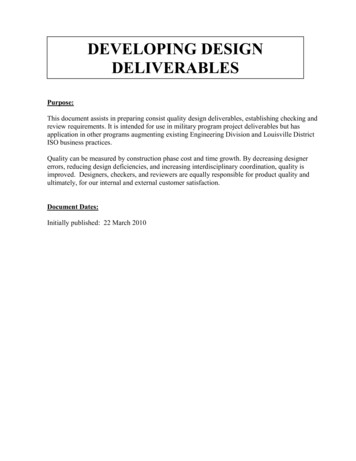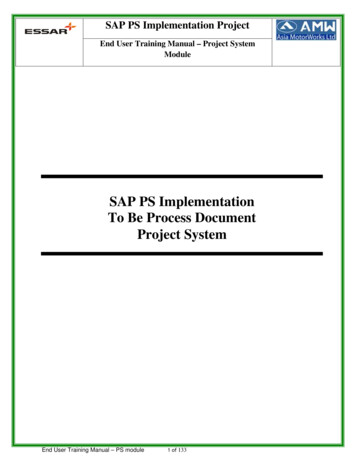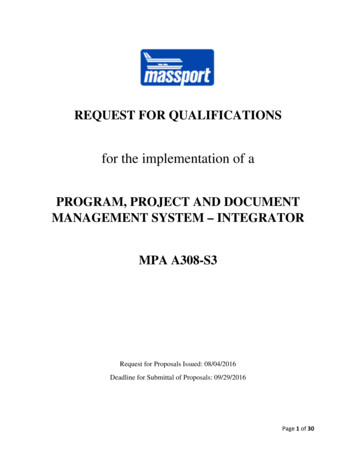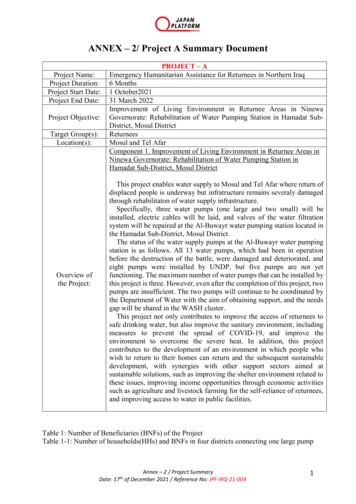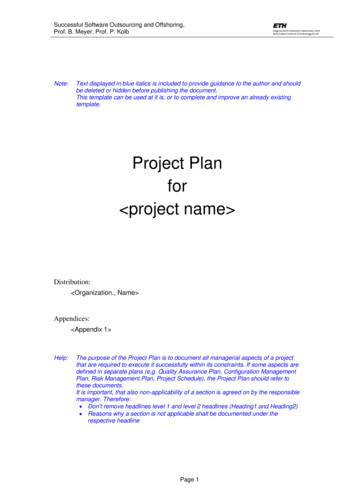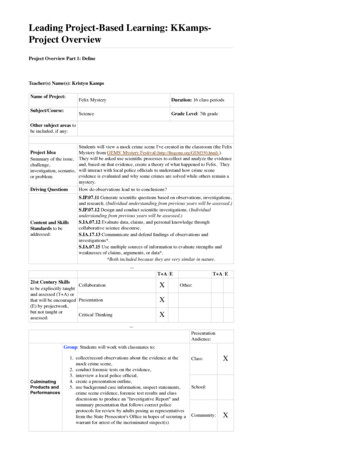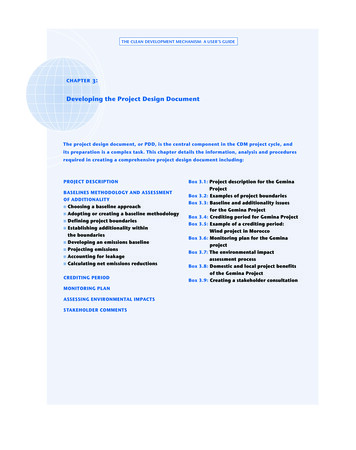
Transcription
THE CLEAN DEVELOPMENT MECHANISM: A USER’S GUIDECHAPTER3:Developing the Project Design DocumentThe project design document, or PDD, is the central component in the CDM project cycle, andits preparation is a complex task. This chapter details the information, analysis and proceduresrequired in creating a comprehensive project design document including:PROJECT DESCRIPTIONBASELINES METHODOLOGY AND ASSESSMENTOF ADDITIONALITY Choosing a baseline approach Adopting or creating a baseline methodology Defining project boundaries Establishing additionality withinthe boundaries Developing an emissions baseline Projecting emissions Accounting for leakage Calculating net emissions reductionsCREDITING PERIODMONITORING PLANASSESSING ENVIRONMENTAL IMPACTSSTAKEHOLDER COMMENTSBox 3.1: Project description for the GeminaProjectBox 3.2: Examples of project boundariesBox 3.3: Baseline and additionality issuesfor the Gemina ProjectBox 3.4: Crediting period for Gemina ProjectBox 3.5: Example of a crediting period:Wind project in MoroccoBox 3.6: Monitoring plan for the GeminaprojectBox 3.7: The environmental impactassessment processBox 3.8: Domestic and local project benefitsof the Gemina ProjectBox 3.9: Creating a stakeholder consultation
THE CLEAN DEVELOPMENT MECHANISM: A USER’S GUIDECHAPTER 3: DEVELOPING THE PROJECT DESIGN DOCUMENTSuccess in steering a project through the CDM processhinges largely on developing a clear, accurate and comprehensive project design document, or PDD. This is thekey document that the host country, investors, stakeholders (local, national and international) and designated operational entities will use to evaluate the project’s potential and judge its merit. Indeed, no projectcan earn CERs without the development, validation andExecutive Board acceptance of a project design document. The project design document needs to clearlydemonstrate that the project will create additionalgreenhouse gas emissions beyond what would haveoccurred in its absence, and that the project will support the host country’s sustainable development path.All aspects of the project design document areimportant. However, the most technically challengingaspects have to do with establishing a baseline andassessing the project’s additionality (see also annex 3).Because completion of the project design document is asubstantial – and expensive – undertaking, projectdevelopers are recommended to stay in close touch withappropriate authorities to make sure the project supports the host country’s sustainable development criteria and that the document meets their standards. Pleasenote that simplified project documentation is requiredfor small-scale projects, as defined in the MarrakechAccords. See chapter 4 for more details on the projectdesign document for small-scale projects.description of opportunities for technology transfer,and explanation of how the reduction in greenhousegas emissions is to be achieved; and Justification that public funding, if used, is not beingdiverted from other uses.Additional recommended information: Project background; Problems and barriers being addressed by the project; Project planning (timetable); Description of the key issues and stages in projectdevelopment (milestones); and Any other information deemed relevant withinreason – lengthy documents generally do not receiveextra attention.Much of this required information can be takendirectly from a business plan or project proposal.Information marked as proprietary or confidential doesnot have to be disclosed, unless this is required under thenational law of the host country. The following information cannot be considered as proprietary or confidential: The determination of whether the emission reductions in anthropogenic emissions are additional; The description of the baseline methodology and itsapplication; and Information supporting an environmental impactassessment requirements.BASELINES METHODOLOGY ANDASSESSMENT OF ADDITIONALITYPROJECT DESCRIPTIONThe first part of the project design document is a description of the project. While some of this information canbe taken from the project idea note, the PDD requiressome additional information as well. At the very minimum the following project information is required: Title of the project activity; Purpose of the project; List of project participants; Technical description of the project, including location, category, technical performance information,36According to Article 12.5c of the Kyoto Protocol, CDMactivities must generate emission reductions additionalto any that would have occurred in the absence of theproject activity. The purpose of the baseline analysis isto provide a transparent picture of what would havehappened without the proposed project. This is commonly referred to as the ‘business-as-usual’ scenario.The analysis also provides information on the estimatedproject emissions.An estimate of greenhouse gas emissions, both in theproject situation and in the absence of the project, is the
CHAPTER 3: DEVELOPING THE PROJECT DESIGN DOCUMENTBOX 3.1: DESCRIPTION OF THE GEMINA PROJECT (PDD EXAMPLE)Title of the project activity: Gemina Rice Husk Project in NicaraguaList of project participants:The Gemina Rice Husk Project is being developed by a joint company, Gemina Generator s. created by Grupo Gemina, aNicaraguan private company, and Bronzeoak Corporation, an independent group, which develops, funds and implements commercial, energy and environmental projects. Gemina operates the Chinandega rice and flourmill complex and is the leadingcompany in that business in Nicaragua. So far, Gemina has bought electricity from the local power distribution company.Purpose of the project:The maximum electrical on-site demand in 2000 was 1034 kW, which is expected to increase to 1200 kW by 2002. The supply of power is somewhat unreliable and the price is highly dependent on the world price of oil. Grupo Gemina is interested inbuilding a biomass power plant to cover on-site electricity demand and to sell the excess electricity.Technical description of the project:The plant will be located in Chinandega, in the same compound as the rice mill and at less than 1 km from an ENTRESA substation. The Rice Husk Power plant will produce 100 per cent of the electrical power used at the mill and would consume 80per cent of the expected husk stream. The proposed power plant will have a capacity of 1.432 MW. The technology proposedis based on the conventional boiler/steam turbine cycle. The husks are fed to the combustor and burned to produce heat. Thesteam generated is passed to a steam turbine, which drives an electrical generator. This basic technology has been in usecommercially for more than 100 years. It has been employed with a wide range of biomass fuels including rice husks. Thesubproject’s construction time is approximately 12 months and completion is expected by summer 2003. Introduction anddemonstration of modern, environmentally friendly power production techniques are an explicit objective of the project. Theproject will demonstrate that emissions reductions from renewable energy can earn additional income and the introduction ofCDM know-how is expected to raise environmental awareness and generate interest in low carbon energy technologies. TheGemina project is the first rice husk energy project introduced successfully into Nicaragua. Similar opportunities includingCO2 reductions are available in the region.Affirmation of non-diversion of ODA:Public resources are not used to fund this project. No affirmation required.foundation for determining the emissions reductionsthat can be claimed under the CDM. The baseline represents a scenario based on certain assumptions, and istherefore a subjective estimation. To maintain the project’s environmental integrity, a conservative approachshould be taken. The selections, assumptions and calculations made should be presented in a clear and transparent manner and the choices justified.The steps to developing a credible and transparentbaseline for a CDM project are: Choosing a baseline approach; Adopting – or creating – a baseline methodology; Defining the project boundaries; Forecasting what emissions would occur under the‘business as usual’ scenario;Assessing future emissions from the project;Assessing leakage, and Calculating projected emission reductions to beclaimed upon future verification.The following sections provide guidance on how todevelop an emission baseline, calculate project emissions and net emission reductions – potentiallyclaimable as CERs – that are the direct result of theproject. See annex 3 for more detailed informationon baseline methodologies. Choosing a baseline approachThe most significant step in setting an emission baseline is selecting the baseline approach, which providesthe basis for a baseline methodology. When presentingthe baseline formula calculations, the emissions should37
THE CLEAN DEVELOPMENT MECHANISM: A USER’S GUIDEbe transparently presented. In the Marrakech Accordsthree different baseline approaches have been identified for CDM projects. These include: Use existing, actual or historical greenhouse gas emissions, as applicable; or Use greenhouse gas emissions from a technology thatrepresents an economically attractive course of action,taking into account the investment barriers; or The average emissions of similar activities undertaken in the previous five years, in similar social,economic, environmental and technological circumstances, and whose performance ranks among thetop 20 percent of their category.Adopting or creating a baseline methodologyA baseline methodology is an application of any of theabove approaches and can be identified on a case-by-casebasis. Before developing the emission baseline it is recommended to check with the CDM Executive Board to seewhat baseline methodologies have been accepted. Thisinformation can be taken from the UNFCCC website,www. unfccc.int/cdm , which includes a reference list ofapproved methodologies. A project developer is free todevelop a new methodology not included in the list.However, a new methodology has to be approved by the CDMExecutive Board before any project developer can use it.Defining the project boundaryIn order to determine which greenhouse gas emissionsneed to be estimated and calculated for establishing theemission baseline and project emissions, the projectboundary has to be defined. A project boundary comprisesall anthropogenic emissions by sources of greenhousegases under the control of the project participants thatare significant and reasonable attributable to the CDMproject activity. The activities and greenhouse gas emissions that are included in the project boundary reflect: Activities that will be included in the emission baseline and baseline calculations; and Activities and greenhouse gas emissions that will bemonitored once the project is operational.The procedures to define the project boundary forthe calculation of the baseline emissions and for theproject emissions should be consistent and similar,whenever possible. However, in some cases they maydiffer. For example, a waste treatment facility devel38oped to digest waste into methane and capture energywould have as its original baseline boundary the existing waste management system, while the project scenario would need to expand its boundary to include thenew equipment (digester, piping and combustion systems), which have their own emission signatures. Thedeveloper should offer sufficiently robust documentation to justify the choice of alternative boundaries.All significant greenhouse gas emission reductionsfrom the proposed CDM activity that are reasonably attributable to the project developer/operator and to the projectactivity should be included in the project boundary. Theproject developer should only assess and describe theimpacts of the project activity on greenhouse gas emissions under his or her control. A useful proxy for estimatingthe ‘under control’ criteria is whether the project developer financially controls the activity. For example, while a project operator will likely financially control the generation of electricity, the operator will not control transport and distribution losses or the transport of fuels to the project. Anyemissions related to these activities can thus be considered outside the project developer’s control, unless theproject activity specifically causes a change in activitylevels that affects emissions (see also annex 3).Setting a project boundary will take into account: Geographic factors should respond to the questions as toover what activities and in which geographical areashould a project be compared? For example, against allsimilar activities in a country, in a specific region, atone specific location, across national borders, or atanother level? Activity level pertains to the activities whose emissionsshould be included in the baseline. For example,should emissions related to the construction of afacility be included or not, should upstream anddownstream emissions be included?To summarize, emissions from activities that aredirectly related to the project output and site locationshould be included within the project boundary.Emissions related to activities not directly related tothe project can be excluded. Exceptions can be madewhen it can be clearly demonstrated that the impacts ofa direct activity are very small, or negligible, comparedto the total. These may be excluded from the project
CHAPTER 3: DEVELOPING THE PROJECT DESIGN DOCUMENTboundary. Conversely, when emissions from indirect oroff-site activities are considered significant and withincontrol of the project developer, these emissions shouldbe included in the project boundary. These impactsshould be estimated on a case-by-case basis and the decisions must be justified.It is recommended that the project boundariesshould be drawn in the form of a flowchart that clearlyshows included and excluded
port the host country’s sustainable development path. All aspects of the project design document are important. However, the most technically challenging aspects have to do with establishing a baseline and assessing the project’s additionality (see also annex 3). Because completion of the project design document is a substantial – and expensive – undertaking, project developers are .
